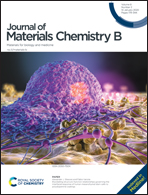Programmed co-delivery of platinum nanodrugs and gemcitabine by a clustered nanocarrier for precision chemotherapy for NSCLC tumors†
Abstract
Recently, ultra-small platinum nanoparticles (USPtNs) have been found that can kill cancer cells by leaching Pt ions into acidic organelles, such as cell endosomes or lysosomes. Unfortunately, tumor-specific accumulation is difficult to achieve with such platinum nanodrugs of less than 5 nm due to their short half-life in vivo and broad range of toxicity to normal tissues. Programmable multi-drug release for combinational chemotherapy by hierarchical nanostructures provides a promising solution for cancer-targeted therapy. Herein, we demonstrated a pH/redox dual stimuli-responsive clustered nanoparticle as a vehicle for simultaneously delivering USPtNs and gemcitabine (GEM) to treat non-small-cell lung cancer. The clustered nanoparticle (denoted as GP-NA) was composed of disulfide-bond-containing GEM-grafted copolymers (PEG-b-P(LL-g-GEM)), pH-sensitive polypeptides (OAPI), and USPtNs. Such a hybrid nanosystem completes multiple tasks inside cancer cells, which include the generation of cytotoxic Pt ions in response to lysosomal acidic environments and the subsequent release of GEM in cytoplasmic reduction environments. Compared with non-acid-sensitive nanoparticles or free drugs, GP-NA exhibited cumulative and enhanced anti-tumor efficacy in vivo, which may be attributed to the simultaneous inhibition of ribonucleotide reductase and DNA replication in nuclei by the GEM and Pt ions. Together, our work provides a promising strategy in the co-delivery of USPtNs and GEM for precision cancer chemotherapy.



 Please wait while we load your content...
Please wait while we load your content...